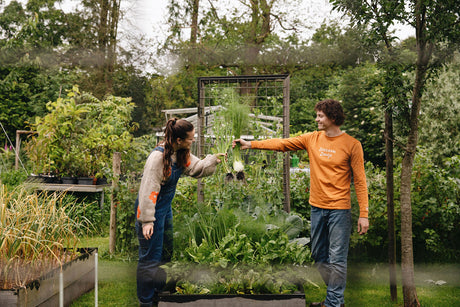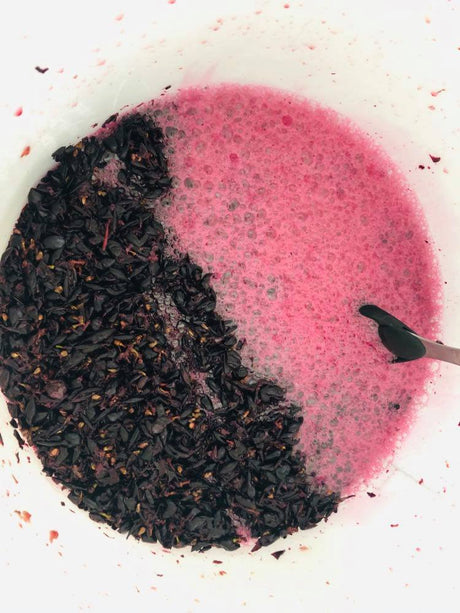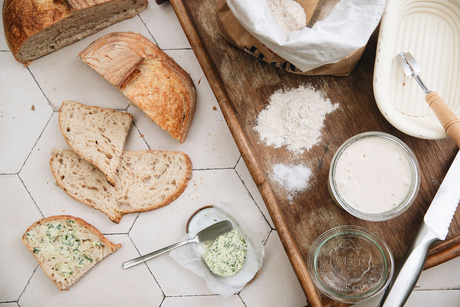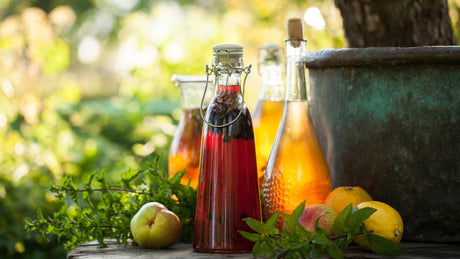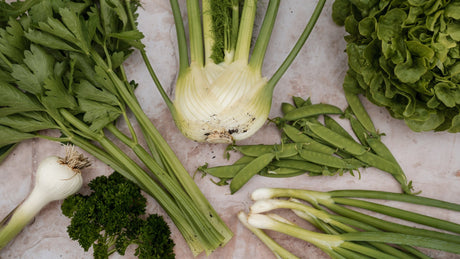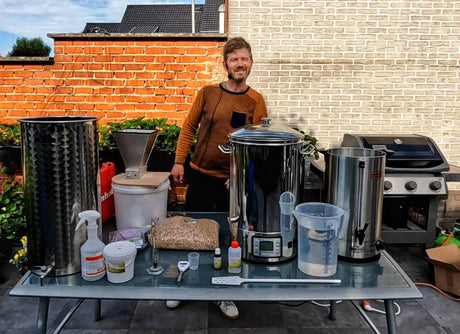Nutritional values in vegetables
Vegetables are healthy. Everyone agrees on that. They are full of proteins, carbohydrates, vitamins and minerals. But what are those things actually? And more importantly ... what do they do in our bodies. The nutritional values are listed at the bottom of each crop that you can reach via the menu on the site. In this article we will tell you what those substances do exactly. This is not a scientific article but research work shared by vegetable gardeners for vegetable gardeners.
note in advance: below are lists of nutritional values per 100 grams. Keep in mind that it is easier to eat 100 grams of broccoli than, for example, 100 grams of parsley
In nutrition we distinguish 6 important nutrients:
Calories
A calorie is the
unit of measurement for
energy . One
calorie is the amount of energy required to heat one gram of pure water 1 degree Celsius. To determine the amount of energy in food, nutritionists use
kilocalories , or 1000 calories. The abbreviation is
Kcal
A calorie is therefore not a nutrient but a unit of energy for all nutrients in our food.
Fat

Fats are nutrients that consist of fatty acids. The fatty acids are divided into
saturated and
unsaturated fatty acids .
Saturated fatty acids are found in meat, dairy products and hardened fats and are not so good for the heart and blood vessels.
Unsaturated fatty acids are found in vegetable oils and fish, they are also often called omega acids. They protect our heart and blood vessels. Vegetables contain unsaturated fats but are only present in very small quantities.
to the top
Carbohydrates in vegetables: Fiber and sugar

In carbohydrates, we distinguish between
simple carbohydrates and
complex carbohydrates . Simple carbohydrates are the least healthy. They mainly consist of
sugar , you probably know the names fructose (in fruit), lactose (in dairy) and sucrose (cane and beets). In addition, you have
complex carbohydrates , which are somewhat more complex. These are the ones that are mainly found
in vegetables . We divide the complex carbohydrates into
starch (digestible) and
fibres (non-digestible). Fibres are mainly found in vegetables and are very healthy for the
intestinal tract in our body. They protect us
against cardiovascular diseases and are
absorbed more gradually by our body. In contrast to sugar. That is why you see cyclists (who absorb energy quickly) taking in sugar on the road and not
artichokes . On the site you can find how much fibre each crop contains? Here is a top 10 (per 100 grams):
-
Artichokes (8.6 grams)
-
Peas (5.5 grams)
-
Green beans (5.3 grams)
-
Parsnip (4.9 grams)
- Kale (4 grams)
-
Brussels sprouts (3.8 grams)
-
Kale (3.6 grams)
-
Broccoli (3.3 grams)
- Sweet potato (3.3 grams)
-
Broad beans (3.2 grams)
to the top
Proteins
Proteins are one of the most important components of our food and make all life possible. All antibodies, enzymes and many hormones are proteins. They are the
taxis for nutrients, oxygen and waste products throughout our body. They provide the structure and contraction of our
muscles . They also provide
collagen (the 'humus of our body') that makes our skin, hair and nails. A vegetable garden top 10 of proteins in vegetables (per 100 grams):
- Lentils (13.1 grams)
-
Green beans (6.8 grams)
-
Peas (5.4 grams)
-
Kale (4.3 grams)
-
Broccoli (3.8 grams)
-
Snow peas (3.5 grams)
-
Corn (3.3 grams)
-
Artichoke (3.3 grams)
-
Spinach (3 grams)
-
Broccoli (2.8 grams)
to the top
Minerals
scroll up for the first part of this article
Ever heard a commercial that says '... is full of vitamins and minerals'? You've probably heard it. In the article 'The soil:
The ABC of the vegetable garden soil ' you can read about minerals in the soil. These minerals also end up in your vegetables. If you have a lot of minerals in your vegetable garden soil, then you also have a lot of minerals in your vegetables. A supermarket vegetable can look very large and healthy, the smaller variety from your own garden can be much healthier.
There are two types of minerals, macro (Latin for large) minerals and trace minerals. The latter are smaller.
Just like vitamins, minerals help your body grow and develop. They also keep you healthy. Minerals help our body in many ways. They provide strong bones, transmit nerve signals, ensure a regular heartbeat and provide our hormones. Hormones are the conductors in your body and give all your cells instructions on what to do in different situations. Here is an overview of the most important minerals in our vegetables:
- Calcium
- Of all the minerals in our body, Calcium is the most present. Calcium helps us form our bones and teeth and is necessary for the clotting of our blood, the transmission of stimuli in nerve cells and the contraction of muscles. Calcium is very efficient against osteoporosis . Of the one to one and a half kilos of calcium in our body, 99% is in our bones and teeth. The Calcium vegetable garden top 10 looks like this (per 100 grams):
-
Kale (232 mg)
-
Turnips (190mg)
-
Arugula (160 mg)
-
Spinach (136 mg)
-
Watercress (120 mg)
-
broccoli (118 mg)
-
Pak Choi (105 mg)
- Okra (82 mg)
-
Garden cress (81 mg)
-
Spring onion (72 mg)
-
phosphorus
- Iron
- Iron is one of the most important minerals in our body. It produces hemoglobin, the oxygen taxi in our body. Red blood cells consist of 1/3 hemoglobin. People with iron deficiency often get tired more quickly. Iron is also an important part of myoglobin, the substance that helps store oxygen in your muscles. Iron is mainly found in meat, fish, eggs and in this vegetable garden top 10:
-
Parsley (42 mg)
-
Borage (31 mg)
-
Purslane (25 mg)
-
Spinach (24 mg)
-
Swiss Chard (23 mg)
- Asparagus (21 mg)
-
Tomato (21 mg)
-
Lamb's lettuce (21 mg)
-
Broccoli (19 mg)
-
Lettuce (19 mg)
- Copper
- Copper is a trace mineral. This means that there is very little of it in our body. It seems very strange that our body contains copper. Copper is the helper of iron in our body and is mainly stored in the liver. Copper ensures that we can absorb iron. And iron in turn ensures the production of red blood cells. A copper deficiency will therefore usually be accompanied by an iron deficiency. Copper is absorbed by our stomach and mucous membrane in our small intestine. Curious which vegetables in the vegetable garden are in the copper top 10 (per 100 grams)?
-
Radicchio (3 mg)
-
Dried beans (3 mg)
-
Cardoon (3 mg)
-
Chicory (3 mg)
-
Potatoes (2 mg)
- Asparagus (3 mg)
-
Swiss Chard (2 mg)
-
Spinach (2 mg)
-
Pickles (2 mg)
-
Tomato (2 mg)

-
Magnesium
-
Magnesium is very important in our body. An overview: It ensures the production of proteins, bones and fatty acids. Fatty acids lower our cholesterol. Magnesium is essential for cell reproduction (in pregnant women), activating vitamin B (see later), muscle relaxation, blood clotting, production of insulin (regulates the sugar level in our blood). It also helps people with the eye disease glaucoma and it lowers your blood pressure. Vegetables rich in magnesium (per 100 grams):
-
Swiss Chard (860 mg)
-
Purslane (850 mg)
-
Spinach (756 mg)
- Horseradish (503 mg)
-
Borage (495 mg)
-
Cardoon (430 mg)
-
Kale (419 mg)
-
Chives (412 mg)
-
Watercress (382 mg)
- Okra (368 mg)
- Manganese
- Manganese is also a trace mineral that is needed in small quantities for the production of enzymes that are necessary for the life of proteins and fat in our body. It supports our immune system, our blood sugar levels, cell reproduction and the growth of our bones. Manganese works together with vitamin K for our blood clotting. In cooperation with vitamin B, manganese ensures a positive outlook when we are confronted with stress, frustration or fear. The anti-stress mineral par excellence. The vegetable garden top 10 (per 100 grams):
- Lemongrass (11 mg)
-
New Zealand spinach (9 mg)
-
Spinach (8 mg)
- Okra (7 mg)
-
Endive (5 mg)
-
Peas (4 mg)
-
Watercress (4 mg)
-
Carrots (4 mg)
-
Swiss chard / Chard (4 mg)
-
Purslane (4 mg)
- Potassium
- This mineral helps some basic functions in our body: our heart rhythm, our blood pressure, our nerve and muscle activity. In addition, it is useful for our carbohydrate and protein metabolism and keeps the Ph values (acid levels) in our body at the right level. Potassium helps with high blood pressure and people who eat a lot of salt benefit from taking this mineral. The vegetable garden top 10 for potassium:
-
Soy sauce (6183 mg)
-
Purslane (6175 mg)
-
Watercress (5999 mg)
-
Swiss Chard (5490 mg)
-
Spinach (4852 mg)
-
Cardoon (4705 mg)
-
Parsley (4649 mg)
-
Coriander (4530 mg)
-
Lamb's lettuce (4371 mg)
-
Zucchini (4371 mg)
- Selenium
- Selenium is a trace mineral. This means that there is very little of it in our body. Selenium activates an enzyme glutathione that helps the body fight cancer. A study shows that men with a selenium diet developed 65% less prostate cancer. Selenium is also good for the immune system and white blood cells, is recommended for older people. And last but not least, selenium increases the activity of sperm cells. The top 10 vegetables that contain selenium (per 100 grams):
- Asparagus (55 micrograms)
-
Spinach (41 micrograms)
-
Parsley (24 micrograms)
-
Broccoli (22 micrograms)
-
Garlic (19 micrograms)
-
Lettuce (red) (19 micrograms)
-
Watercress (16 micrograms)
-
Red cabbage (16 micrograms)
-
New Zealand spinach (15 micrograms)
-
Potatoes (15 micrograms)

- Sodium
- This mineral helps to maintain our blood volume and regulates the amount of water in our cells. The kidneys regulate the amount of sodium in our body. 1 tablespoon of salt contains 4 x the amount of salt that we need daily. Too much salt is therefore bad for the kidneys and high blood pressure. Salt is added a lot in (calorie rich) foods for taste and is therefore very dangerous.
-
Celeriac (156 mg)
-
Onions / Onion (6.4 mg)
-
Beetroot (106 mg)
-
Lettuce (1.3 mg)
-
Carrots (204 mg)
-
Celery (88 mg)
-
Radish (45 mg)
-
Swiss Chard (313 mg)
-
Endive (113 mg)
-
Parsley (33.6 mg)
- Zinc :
to the top
 Fats are nutrients that consist of fatty acids. The fatty acids are divided into saturated and unsaturated fatty acids . Saturated fatty acids are found in meat, dairy products and hardened fats and are not so good for the heart and blood vessels. Unsaturated fatty acids are found in vegetable oils and fish, they are also often called omega acids. They protect our heart and blood vessels. Vegetables contain unsaturated fats but are only present in very small quantities.
to the top
Fats are nutrients that consist of fatty acids. The fatty acids are divided into saturated and unsaturated fatty acids . Saturated fatty acids are found in meat, dairy products and hardened fats and are not so good for the heart and blood vessels. Unsaturated fatty acids are found in vegetable oils and fish, they are also often called omega acids. They protect our heart and blood vessels. Vegetables contain unsaturated fats but are only present in very small quantities.
to the top
 In carbohydrates, we distinguish between simple carbohydrates and complex carbohydrates . Simple carbohydrates are the least healthy. They mainly consist of sugar , you probably know the names fructose (in fruit), lactose (in dairy) and sucrose (cane and beets). In addition, you have complex carbohydrates , which are somewhat more complex. These are the ones that are mainly found in vegetables . We divide the complex carbohydrates into starch (digestible) and fibres (non-digestible). Fibres are mainly found in vegetables and are very healthy for the intestinal tract in our body. They protect us against cardiovascular diseases and are absorbed more gradually by our body. In contrast to sugar. That is why you see cyclists (who absorb energy quickly) taking in sugar on the road and not artichokes . On the site you can find how much fibre each crop contains? Here is a top 10 (per 100 grams):
In carbohydrates, we distinguish between simple carbohydrates and complex carbohydrates . Simple carbohydrates are the least healthy. They mainly consist of sugar , you probably know the names fructose (in fruit), lactose (in dairy) and sucrose (cane and beets). In addition, you have complex carbohydrates , which are somewhat more complex. These are the ones that are mainly found in vegetables . We divide the complex carbohydrates into starch (digestible) and fibres (non-digestible). Fibres are mainly found in vegetables and are very healthy for the intestinal tract in our body. They protect us against cardiovascular diseases and are absorbed more gradually by our body. In contrast to sugar. That is why you see cyclists (who absorb energy quickly) taking in sugar on the road and not artichokes . On the site you can find how much fibre each crop contains? Here is a top 10 (per 100 grams):




